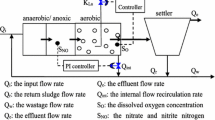Abstract
The design and development of the neural network (NN)-based controller performance for the activated sludge process in sequencing batch reactor (SBR) is presented in this paper. Here we give a comparative study of various neural network (NN)-based controllers such as the direct inverse control, internal model control (IMC) and hybrid NN control strategies to maintain the dissolved oxygen (DO) level of an activated sludge system by manipulating the air flow rate. The NN inverse model-based controller with the model-based scheme represents the controller, which relies solely upon the simple NN inverse model. In the IMC, both the forward and inverse models are used directly as elements within the feedback loop. The hybrid NN control consists of a basic NN controller in parallel with a proportional integral (PI) controller. Various simulation tests involving multiple set-point changes, disturbances rejection and noise effects were performed to review the performances of these various controllers. From the results it can be seen that hybrid controller gives the best results in tracking set-point changes under disturbances and noise effects.






















Similar content being viewed by others
References
Hussain MA (1999) Review of the applications of neural network in chemical process control-simulation and online implementation. Artif Intell Eng 13:55–68
Olsson G, Rundqwist L, Eriksson L, Hall L (1985) Self-tuning control of dissolved oxygen concentration in activated sludge systems. In: Drake RAR (ed) International symposium instrumentation and control of water and wastewater treatment and transport systems. Advances in water pollution control. IAWPRC, Pergamon Press, pp 473–480
Holmberg U, Olsson G, Andersson B (1989) Simultaneous DO control and respiration estimation. Water Sci Technol 21:1185–1195
Lindberg CF, Carlsson B (1996) Non-linear and set-point control of the dissolved oxygen concentration in an activated sludge process. Water quality international ’96. Conference—wastewater treatment plants and sewerage systems, Singapore, pp 203–210
Lindberg CF (1997) Control and estimation strategies applied to the activated sludge process. Ph.D. Thesis, Department of Material Science, System and Control Group, Uppsala University, Sweden
Yoo CK, Park JH, Lee I (1999) Indirect adaptive generic model control for the automatic do control in the activated sludge process. The proceedings of the 8th APCChE congress, Korea, pp 359–362
Zhao H, Isaacs S, Henze M (1994) A novel control strategy for improved nitrogen removal in an alternating activated sludge process. Part 2: control development. Water Res 28:535
Isaacs S, Henze M, Kummel M (1995) An adaptive algorithm for external carbon addition to an alternating activated sludge process for nutrient removal from wastewater. Chem Eng Sci 50(4):617–629
Yoo CK, Cho JH, Kwak HJ, Choi SK, Chun HD, Lee I (2001) Closed-loop identification and control for do concentration in the full-scale cokes wastewater treatment plant. Water Sci Technol 43(7):207–214
Yoo CK, Lee I (2003) Supervisory do control and comparisons of process identification methods in the full-scale wastewater treatment plant. Korean J Chem Eng
Capodaglio AG, Jones HV, Feng X (1991) Sludge bulking analysis and forecasting: application of system identification and artificial neural computing technologies. Water Res 25(10):1217–1224
Cote M, Grandjean BPA, Lessard P, Thibault J (1995) Dynamic modeling of the activated sludge process: improving prediction using neural networks. Water Res 29(4):995–1004
Zhao H, Hao OJ, McAvoy TJ (1999) Approaches to modeling nutrient dynamics: ASM2, simplified model and neural nets. Water Sci Technol 39(1):227–234
Olsson G, Newell B (1999) Wastewater treatment system-modeling, diagnosis and control. IWA Publishing, UK
Haykin S (1994) Neural networks—a comprehensive foundation. Mac Mill, New York
Zhang Q, Stephen JS (1999) Real-time water treatment process control with artificial neural networks. J Environ Eng 125(2):153–160
Hamoda MF, Al-Ghusain IA, Hassan AH (1999) Integrated wastewater treatment plant performance evaluation using artificial neural network. Water Sci Technol 40(7):55–65
Cohen A, Janssen G, Brewster SD, Seeley R, Booger AA, Graham AA, Mardani MR, Clarke N, Kasabov NK (1997) Application of computational intelligence for on-line control of a sequencing batch reactor (SBR) at Morrinsville sewage treatment plant. Water Sci Technol 35(10):63–71
Orhon D, Cimist Y, Tunay O (1986) Substrate removal mechanism for sequencing batch reactors. Water Sci Technol 18:21–33
Henze M, Grady CPL, Gujer W, Marais GVR, Matsuno T (1987) Activated sludge model no.1 (ASM 1), IAWPRC scientific and technical report no. 1. IAWPRC, London
Azwar, Hussain MA, Ramachandran KB (2005) Modeling and dynamic simulation of activated sludge process in sequencing batch reactor. Dev Chem Eng Miner Process (Aust Res J) 13(5/6):675–686
Lau AD, Strom PF, Jenkins D (1984) Growth kinetics of sphaerotilus natans and a floc former in pure and dual continuous culture. J Water Pollut Control Fed 56:41–51
Dold PL, Marais GVR (1986) Evaluation of the general activated sludge model proposed by the IAWPRC task group. Water Sci Technol 18:63–71
Olsson G, Andrews JF (1987) The dissolved oxygen profile—a valuable tool for control of the activated sludge process. Water Res 12:986–1004
Author information
Authors and Affiliations
Corresponding author
Rights and permissions
About this article
Cite this article
Azwar, ., Hussain, M.A. & Ramachandran, K.B. The study of neural network-based controller for controlling dissolved oxygen concentration in a sequencing batch reactor. Bioprocess Biosyst Eng 28, 251–265 (2006). https://doi.org/10.1007/s00449-005-0031-2
Received:
Accepted:
Published:
Issue Date:
DOI: https://doi.org/10.1007/s00449-005-0031-2




